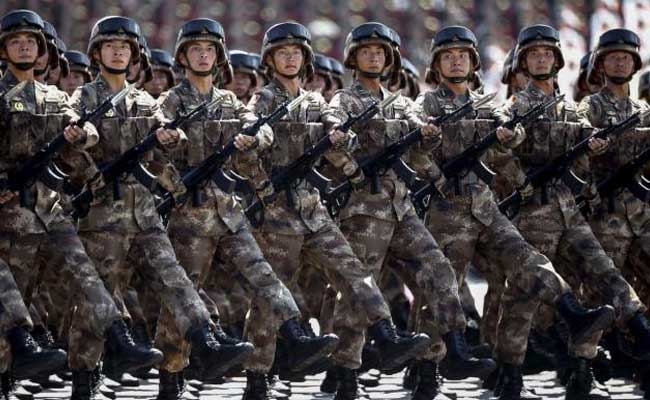China's Military Buildup: A Threat To America's Global Standing?

Table of Contents
China's Expanding Military Capabilities
China's military modernization is a multifaceted undertaking, encompassing significant advancements across various domains. This rapid expansion is fueled by substantial investment and a clear strategic vision to project power globally.
Naval Expansion
China's naval expansion is perhaps the most visually striking aspect of its military buildup. The People's Liberation Army Navy (PLAN) is rapidly expanding its fleet, acquiring modern aircraft carriers, destroyers, submarines, and other advanced vessels.
- New Ship Classes: The PLAN has introduced several new classes of destroyers (Type 055), frigates (Type 054A), and nuclear-powered submarines, significantly bolstering its naval capabilities.
- Expansion of Naval Bases: China has established naval bases in Djibouti, providing a strategic foothold in the Horn of Africa and expanding its ability to project naval power into the Indian Ocean.
- Increased Naval Exercises: The frequency and scale of PLAN exercises have increased dramatically, demonstrating China's growing confidence and proficiency in naval operations. These exercises often involve complex maneuvers and long-range deployments, showcasing the PLAN's increasing operational readiness. This demonstrates a growing capacity for naval power projection in the South China Sea and beyond.
This expansion significantly enhances China's capacity for power projection and challenges traditional US naval dominance in key regions, specifically affecting maritime security and freedom of navigation.
Advancements in Air Power
China's air force, the People's Liberation Army Air Force (PLAAF), has also undergone a remarkable transformation. Significant advancements in stealth technology, long-range bombers, and precision-guided munitions have fundamentally altered the balance of air power in the region.
- Stealth Fighter Jets: The J-20 stealth fighter jet, a fifth-generation fighter comparable to the US F-22 Raptor, represents a significant leap forward in China's air power capabilities.
- Long-Range Bombers: The development and deployment of long-range bombers, such as the H-6K, extend China's reach and increase its ability to strike targets far from its borders.
- Advanced Missiles: China has invested heavily in developing advanced air-to-air and air-to-ground missiles, significantly improving the accuracy and lethality of its air force.
These advancements in air power directly challenge the US's air superiority in the region, creating a more complex and potentially dangerous security environment.
Space and Cyber Warfare Capabilities
China's ambition extends beyond land and sea, encompassing significant investments in space and cyber warfare capabilities. These domains are increasingly crucial to military operations and national security.
- Satellite Technology: China has developed sophisticated satellite technology for navigation, surveillance, and communication, enabling enhanced military operations and intelligence gathering. They are also increasingly investing in anti-satellite weapons.
- Cyber Espionage and Attacks: China is increasingly leveraging cyber capabilities for espionage, theft of intellectual property, and disruption of critical infrastructure, representing a significant challenge to global cybersecurity.
These capabilities contribute to China's overall military power projection and demonstrate a clear intent to challenge existing norms in these increasingly important domains. This also presents significant cybersecurity challenges to the US and its allies.
Geopolitical Implications and Regional Instability
China's expanding military capabilities have profound geopolitical implications and contribute to growing regional instability.
South China Sea Disputes
China's assertive actions in the South China Sea, including extensive island building and aggressive maritime claims, have escalated tensions with neighboring countries and raised concerns about freedom of navigation.
- Island Building: China's construction of artificial islands in the South China Sea, complete with military installations, has dramatically altered the geopolitical landscape of the region.
- Maritime Disputes: These actions have fueled disputes with several countries, including the Philippines, Vietnam, and Malaysia, increasing the risk of armed conflict.
- Freedom of Navigation: China's claims undermine the principle of freedom of navigation, a cornerstone of international law and crucial for global trade.
The South China Sea disputes are a clear example of how China's military buildup directly affects regional stability and international norms.
Taiwan Strait Tensions
China's military buildup has significantly heightened tensions across the Taiwan Strait. Beijing considers Taiwan a breakaway province and has not ruled out the use of force to achieve reunification.
- Military Posturing: China's military exercises and provocative actions near Taiwan underscore the increasing risk of conflict.
- US Support for Taiwan: The US commitment to Taiwan's defense complicates the situation and raises the stakes for potential conflict.
- Potential Scenarios for Conflict: A variety of scenarios for potential military conflict exist, ranging from limited skirmishes to all-out war.
The situation in the Taiwan Strait represents one of the most significant flashpoints in the region, and a potential major confrontation between China and the US.
The US Response and Strategic Adjustments
The US is responding to China's military buildup through a combination of military, economic, and diplomatic strategies.
US Military Posture in the Indo-Pacific
The US is strengthening its military posture in the Indo-Pacific region to counter China's growing influence.
- Military Bases: The US maintains a significant military presence in the region, including bases in Japan, South Korea, and elsewhere.
- Alliances: The US is strengthening its alliances with countries in the region, such as through the Quadrilateral Security Dialogue (Quad) involving the US, Japan, Australia, and India.
- Joint Military Exercises: Regular joint military exercises enhance interoperability and demonstrate the US's commitment to its allies.
This enhanced military presence aims to deter Chinese aggression and maintain regional stability.
Economic and Diplomatic Strategies
Beyond military means, the US is employing economic and diplomatic strategies to counter China's influence.
- Economic Sanctions: Targeted sanctions are used to pressure China on issues like human rights and intellectual property theft.
- Technological Competition: The US is investing heavily in technological development to maintain its edge over China in crucial areas.
- Diplomatic Pressure: The US is working to build international coalitions to counter China's assertive behavior.
Conclusion
China's military buildup is a multifaceted and significant development with far-reaching geopolitical implications. The expansion of the PLAN, advancements in air and space capabilities, and assertive actions in the South China Sea and Taiwan Strait all contribute to a more complex and potentially dangerous security environment. While the US is responding through military adjustments, economic pressure, and diplomatic initiatives, the extent to which these efforts can effectively counter China's growing military power remains a critical question. Whether this buildup represents a direct and immediate threat to America's global standing is a matter of ongoing debate, requiring nuanced analysis and careful consideration of various factors. However, it undeniably represents a significant challenge requiring continued vigilance and proactive strategies from the US and its allies.
Understanding China's military buildup is crucial for navigating the complexities of 21st-century geopolitics. Continue your research and stay informed about this critical issue by exploring further resources on China's military modernization and its implications for US foreign policy.

Featured Posts
-
 Tain Offers Temporary Space For Rogart Veterinary Practice After Fire
May 31, 2025
Tain Offers Temporary Space For Rogart Veterinary Practice After Fire
May 31, 2025 -
 Medvedev And Tsitsipas Advance At Indian Wells Berrettini Falls
May 31, 2025
Medvedev And Tsitsipas Advance At Indian Wells Berrettini Falls
May 31, 2025 -
 Arese Borromeo Ladri Di Biciclette Fotografie Del Neorealismo Italiano
May 31, 2025
Arese Borromeo Ladri Di Biciclette Fotografie Del Neorealismo Italiano
May 31, 2025 -
 Banksy In Dubai A First Time Showcase Of Iconic Artworks
May 31, 2025
Banksy In Dubai A First Time Showcase Of Iconic Artworks
May 31, 2025 -
 Sanofi Uebernimmt Medikament Gegen Autoimmunerkrankungen Fuer Bis Zu 1 9 Milliarden Us Dollar
May 31, 2025
Sanofi Uebernimmt Medikament Gegen Autoimmunerkrankungen Fuer Bis Zu 1 9 Milliarden Us Dollar
May 31, 2025
